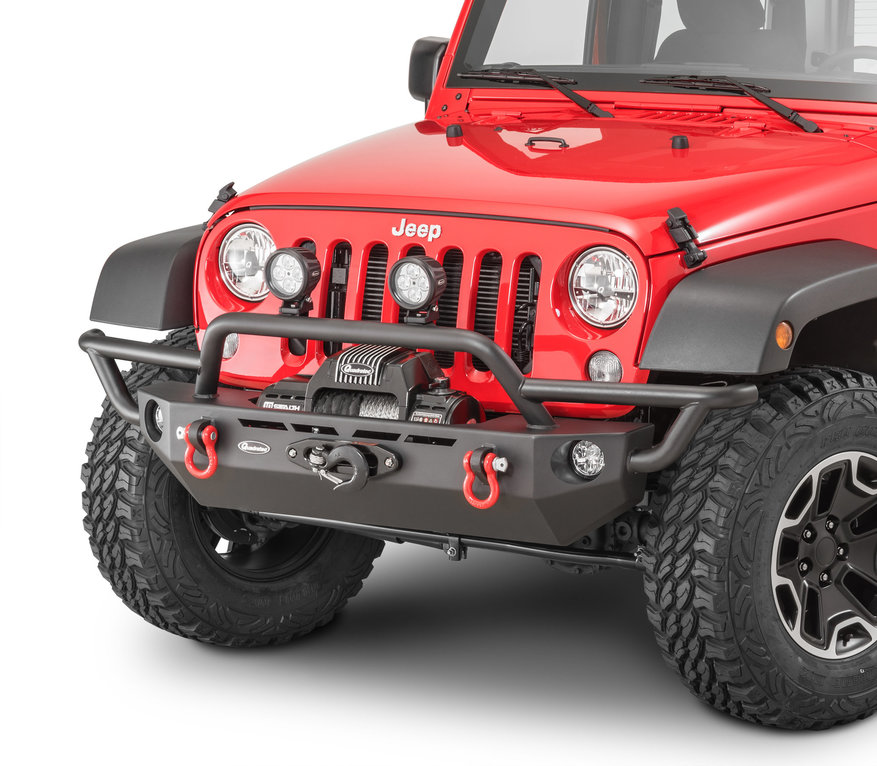by Rick Rotondo
Torque Staff Writer
Off-roading is one of the most exciting, and rewarding, activities you can do with your Jeep.
Taking that vehicle and splashing through muddy puddles miles away from anywhere, cruising a dirt trail around thick wilderness, gliding over sand with the ocean a few feet away, or inching along carefully across rock obstacles.
These pursuits all take you and your Jeep away from the crowds and pavement to some of the more remote destinations on Earth. So it only makes sense to add a winch for peace of mind during your off-road adventures. After all, you never know when something could happen on the trail — either to you, or someone in your group.
But, how do you mount a winch on your Jeep? Does it require a different bumper setup than the factory version? Are other parts needed? And how does it actually attach?
Well, first off, yes, you can mount a winch on most factory plastic bumpers. For those who own a CJ, Wrangler YJ, TJ, JK, JL, or Gladiator JT with this type of bumper, several manufacturers offer pretty slick winch mounting plates that coexist with your factory bumper. In most cases, these mounting plates place your new winch up above the factory bumper. For CJ, Wrangler YJ and TJ, you can choose from a standard or raised mount that allows it to work with specific bumper types — i.e. tubular bumpers with cutouts to accept a winch. Installation usually requires the removal of your factory bumper, and the winch plate will then bolt to your Jeep’s frame and accept the winch. Once the factory bumper is reinstalled, you can get going on the trail.
By mounting it this way, you don’t have to worry about adding the extra weight of a heavy aftermarket bumper, plus it is easier to remove the winch if you want it off for any period of time. This combination is usually a decent set up for winches with around 8,000-pound pulling power, and for those who may only off-road a few times a year.
Another way to mount your Jeep winch is to install a stronger aftermarket front bumper on the vehicle. These heavier-duty bumpers offer considerably more options and advantages than a factory plastic bumper installation — especially if your plans do involve hitting the trail as much as you can during the year.
Aftermarket front winch bumpers utilize a fully-welded steel construction, making them stronger and more durable, while also giving the winch a lower pulling point, providing better protection from impacts and allowing for better airflow through the grille area. Plus, these rugged-looking bumpers have an appearance that is a great head-turner when driving around town.
Most aftermarket bumpers also come with an integrated mounting plate so the winch installation does not take much work, and many even come with a protective grille guard — or stinger — that provides additional protection against trail obstacles like brush and branches that could impact the winch on a factory bumper set up.
These aftermarket winch bumpers usually offer some degree of personalization as well, and can be found in stubby, mid-width and full sizes to accommodate nearly everyone’s sense of style. Modular series winch bumpers offer customization options that allow you to add more side and top protection to protect the winch.
Now, what if your Jeep came from the factory with a metal winch-style bumper instead of plastic? Well, if you have a 2013-2018 10th Anniversary Edition Wrangler JK; ‘07-‘18 Call of Duty, Moab, Back Country, Winter, or Premium Edition Wrangler JK; or ‘18-‘21 Wrangler JL or Gladiator JT with the factory steel bumper, then all you need is a specific Mopar Winch Mounting Plate to install the winch. You simply bolt the Winch Mounting Kit to your bumper, mount the winch, reinstall everything and you are ready for the trails. As a note —in some cases, additional hardware such as the Mopar Fairlead Adapter may be required for your application.
Overall, mounting a winch to your Jeep is a pretty straightforward project. Once you confirm what bumper you have, what type of mount or replacement bumper you need, select the winch that best suits your requirements and have all the parts on your doorstep, you should only be a few hours away from having the ability to self recover — or assist in the recovery of your friends and fellow trail riders.





















